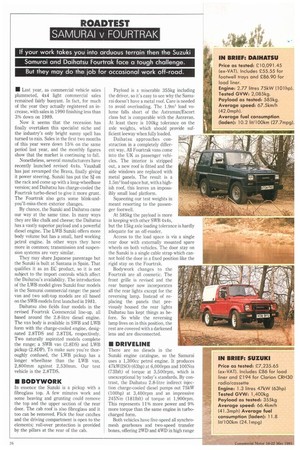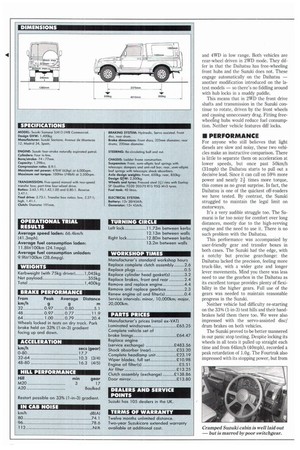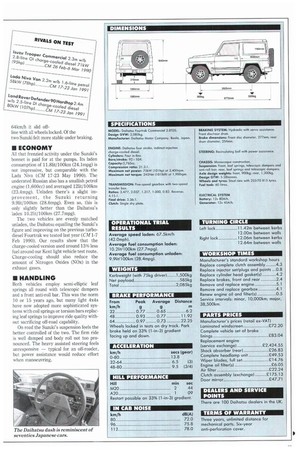ROADTEST SAMURAI v FOURTRAK
Page 28

Page 30

Page 31

Page 32

If you've noticed an error in this article please click here to report it so we can fix it.
If your work takes you into arduous terrain then the Suzuki Samurai and Daihatsu Fourtrak face a tough challenge. But they may do the job for occasional work off-road.
• Last year, as commercial vehicle sales plummeted, 4x4 light commercial sales remained fairly buoyant. In fact, for much of the year they actually registered an increase, with sales in 1990 finishing less than 3% down on 1989.
Now it seems that the recession has finally overtaken this specialist niche and the industry's only bright sunny spell has turned to rain. Sales in the first two months of this year were down 15% on the same period last year, and the monthly figures show that the market is continuing to fall.
Nonetheless, several manufacturers have recently launched revised 4x4s. Vauxhall has just revamped the Brava, finally giving it power steering. Suzuki has put the SJ on the rack and come up with a long-wheelbase version; and Daihatsu has charge-cooled the Fourtrak turbo-diesel to give it more grunt. The Fourtrak also gets some blink-andyou'll-miss-them exterior changes.
By chance, the Suzuki and Daihatsu came our way at the same time. In many ways they are like chalk and cheese; the Daihatsu has a vastly superior payload and a powerful diesel engine. The LWB Suzuki offers more body volume but has a small, hard working petrol engine. In other ways they have more in common; transmission and suspension systems are very similar.
They may share Japanese parentage but the Suzuki is built at Santana in Spain. That qualifies it as an EC product, so it is not subject to the import controls which affect the Daihatsu's availability. The introduction of the LWB model gives Suzuki four models in the Samurai commercial range: the panel van and two soft-top models are all based on the SWB models first launched in 1981.
Daihatsu also fields four models in the revised Fourtrak Commercial line-up, all based around the 2.8-litre diesel engine. The van body is available in SWB and LWB form with the charge-cooled engine, designated 2.8TDS and 2.8TDL respectively. Two naturally aspirated models complete the range; a SWB van (2.8DS) and LWB pickup (2.8DP). To make sure you're thoroughly confused, the LWB pickup has a longer wheelbase than the LWB van, 2,800mm against 2,530mm. Our test vehicle is the 2.8TDS.
• BODYWORK
In essence the Suzuki is a pickup with a fibreglass top. A few minutes work and some heaving and grunting could remove the top and the upper section of the rear door. The cab roof is also fibreglass and it too can be removed. Flick the four catches and the driving compartment is open to the elements; roll-over protection is provided by the pillars at the rear of the cab.
Payload is a miserable 355kg including the driver, so it's easy to see why the Samurai doesn't have a metal roof. Care is needed to avoid overloading. The 1.9m3 load volume falls short of the Astramax/Escort class but is comparable with the Astravan. At least there is 100kg tolerance on the axle weights, which should provide sufficient leeway when fully loaded.
Daihatsu approaches construction in a completely different way. All Fourtrak vans come into the UK as passenger vehicles. The interior is stripped out, a new roof is fitted and the side windows are replaced with metal panels. The result is a 1.5m load space but, with a highish roof, this leaves an impossibly small load platform.
Squeezing our test weights in meant resorting to the passenger footwell.
At 585kg the payload is more in keeping with other SWB 4x4s, but the 15kg axle loading tolerance is hardly adequate for an off-roader.
Access to the load space is via a single rear door with externally mounted spare wheels on both vehicles. The door stay on the Suzuki is a single cable strap which cannot hold the door in a fixed position like the rigid stay on the Fourtrak.
Bodywork changes to the Fourtrak are all cosmetic. The front grille is revised and the rear bumper now incorporates all the rear lights except for the reversing lamp. Instead of replacing the panels that previously housed the rear lights Daihatsu has kept things as before. So while the reversing lamp lives on in this position, the rest are covered with a darkened lens and are disconnected.
• DRIVELINE
There are no diesels in the Suzuki engine catalogue, so the Samurai uses a 1,300cc petrol engine. It produces 47kW(ISO) (63hp) at 6,000rpm and 100Nm (731bft) of torque at 3,500rpm, which is unexceptional by today's standards. By contrast, the Daihatsu 2.8-litre indirect injection charge-cooled diesel pumps out 75kW (100hp) at 3,400rpm and an impressive 245Nm (1811bft) of torque at 1,900rpm. This represents 11% more power and 9% more torque than the same engine in turbocharged form.
Both vehicles have five-speed all synchromesh gearboxes and two-speed transfer boxes, offering 2WD and 4WD in high range
and 4WD in low range. Both vehicles are rear-wheel driven in 2WD mode. They differ in that the Daihatsu has free-wheeling front hubs and the Suzuki does not. These engage automatically on the Daihatsu another modification introduced on the latest models so there's no fiddling around with hub locks in a muddy puddle.
This means that in 2WD the front drive shafts and transmission in the Suzuki continue to rotate, driven by the front wheels and causing unnecessary drag. Fitting freewhedmg hubs would reduce fuel consumption. Neither vehicle features diff locks.
• PERFORMANCE
For anyone who still believes that light diesels are slow and noisy, these two vehicles make an instructive comparison. There is little to separate them on acceleration at lower speeds, but once past 50km/h (31mph) the Daihatsu starts to pull out a decisive lead. Since it can call on 59% more power and nearly 2i times more torque, this comes as no great surprise. In fact, the Daihatsu is one of the quickest off-roaders we have tested. By contrast, the Suzuki struggled to maintain the legal limit on motorways.
It's a very audible struggle too. The Samurai is far too noisy for comfort over long distances, mostly due to the high-revving engine and the need to use it. There is no such problem with the Daihatsu.
This performance was accompanied by user-friendly gear and transfer boxes in both cases. The Suzuki had the edge, with a notchy but precise gearchange: the Daihatsu lacked the precision, feeling more truck-like, with a wider gate and longer lever movements. Mind you there was less need to use the gearbox in the Daihatsu as its excellent torque provides plenty of flexibility in the higher gears. Full use of the gears was needed to maintain reasonable progress in the Suzuki.
Neither vehicle had difficulty re-starting on the 33% (1-in-3) test hills and their handbrakes held them there too. We were also impressed with the servo-assisted disc/ drum brakes on both vehicles.
The Suzuki proved to be better mannered in our panic stop testing. Despite locking its wheels in all tests it pulled up straight each time and from 64km/h (40mph), recorded a peak retardation of 1.0g. The Fourtrak also impressed with its stopping power, but from
• ECONOMY
All that frenzied activity under the Suzuki's bonnet is paid for at the pumps. Its laden consumption of 11.81it/100km (24.1mpg) is not impressive, but comparable with the Lada Niva (CM 17-23 May 1990). The underated Russian also has a smallish petrol engine (1,600cc) and averaged 121it/100km (23.4mpg). Unladen there's a slight improvement, the Suzuki returning 9.91it/100km (28.6mpg). Even so, this is only slightly better than the Daihatsu's laden 10.21it/100km (27.7mpg).
The two vehicles are evenly matched unladen, the Daihatsu equalling the Suzuki's figure and improving on the previous turbodiesel Fourtrak we tested last year (CM 1-7 Feb 1990). Our results show that the charge-cooled version used around 13% less fuel around our Kent light vehicle test route. Charge-cooling should also reduce the amount of Nitrogen Oxides (N0x) in the exhaust gases.
• HANDLING
Both vehicles employ semi-elliptic leaf springs all round with telescopic dampers and a front anti-roll bar. This was the norm 10 or 15 years ago, but many light 4x4s have now adopted more sophisticated systems with coil springs or torsion bars replacing leaf springs to improve ride quality without sacrificing off-road capability.
On road the Suzuki's suspension feels the better controlled of the two. The firm ride is well damped and body roll not too pronounced. The heavy assisted steering feels unresponsive typical for an off-roader, but power assistance would reduce effort when manoeuvring.
The taller Daihatsu feels cruder. The suspension is not so well damped and the ride feels nervous over uneven surfaces. Power assisted steering makes maoeuvring simpler than in the Suzuki but large roll angles discourage any exploration of its handling capabilities.
Off-road, it's much the same story. The Suzuki feels more capable because of its better controlled suspension movements. The Daihatsu does not inspire confidence because of its underdamped suspension, which heightens awareness of its high centre of gravity, comparatively narrow track and short wheelbase. In our test last year, we commented on the crudeness of the Fourtrak's suspension and it's a pity this has not been addressed in the facelifted models. We found it all too easy to lift an inside wheel when cornering off-road.
We found that the Suzuki would go everywhere we took the Daihatsu, although the greater lugging power of the diesel made the job seem easier.
• INTERIOR
Space is at a premium in the Suzuki cab, both for humans and odds and ends. The narrow cab lacks elbow room and has insufficient seat travel for taller drivers. Stowage is restricted to a small lockable glovebox and parcel shelf on the passenger side and a tiny cubby above the centre air vents.
The Fourtrak feels positively spacious by comparison but, like the Isuzu Trooper, the interior is reminiscent of a 10-year-old Japanese car with outdated fascia mouldings, switchgear and instruments.
The Suzuki's instruments contrive to look more modern, but the bank of warning lights beneath them are poorly lit and difficult to see in the daylight. Minor switchgear also needs a re-think. A bank of three rocker switches is mounted at the bottom of the dash to the right of the steering column. These control the heated rear window, hazard and rear fog lamps. None are illuminated at night, making it impossible to find them in the dark. The Land Rover has a similar layout — not surprising since the two used to be built side by side at the Santana plant.
Both vehicles should be easy to clean out; the Suzuki has easily removable rubber mats and the Daihatsu has removable moulded footwell trays. Overall the Daihatsu is better finished, although it lacks a radio and has blanking plugs in the centre of the fascia where some of the instruments have been removed in its conversion. Heating and ventilation is effective in both, aided in the Suzuki, by the removable roof panel.
The Daihatsu has much better visibility thanks to its larger glass area and effective internally adjustable door mirrors. The Suzuki, by contrast, has cheap looking flat mirrors which left large blind spots down both sides of the vehicle, turning overtaking into a tricky operation and compromising safety. The situation was made worse because the mirrors would not stay in one position, gradually tilting back with the pressure of wind and vibration. Properly mounted convex mirrors like those fitted to the Fourtrak would solve the problems.
• SUMMARY
In essence, neither vehicle has changed much since the early eighties. At the time their basic suspension systems were not out of place, but things have changed and it leaves them both very much toward the bottom of the 4x4 heap. The cheaper Lada Niva at £5,630 (ex-VAT) is better off-road, thanks to its superior suspension and 4WD system, even if it is otherwise crude. The Isuzu Trooper (£10,300, ex-VAT) is the Fourtrak's closest rival, but it is a more competent all-rounder, even rivalling the Daihatsu's excellent charge-cooled diesel engine with a superbly refined direct-injection turbo-diesel.
The latest 4x4s from Japan, the new Toyota Landcruiser and Mitsubishi Shogun, clearly point the way ahead for Japanese development in this sector. They are capable competitors in the Range Rover market and while neither is sold in commercial guise in the UK, both manufacturers build other commercial 4x4s, which could benefit from spin-off developments.
Our feeling is that the Daihatsu facelift is designed to buy the Fourtrak time while its replacement is prepared for launch, probably in the next year or two. Let's hope that chassis developments will be introduced at the same time.
In the meantime Land Rover need not worry: the limited off-road ability of the Suzuki and Daihatsu poses no threat to the Defender. Both work best as on-road vehicles for occasional off-road use, but many pickups still provide a better alternative for commercial use.
0 by John Kendall


















































































